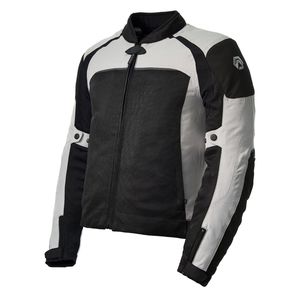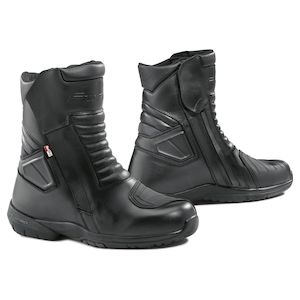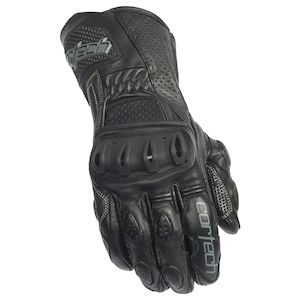When Ducati first unveiled its new SuperSport nearly two years ago, I looked at the specs, noted the availability of factory panniers and thought, "Great, someone has finally built a sport-touring motorcycle to my personal specifications." Ducati, meanwhile, was positioning the SuperSport as a sport bike made rational for the street.
But you can't believe the marketing speak, right? I knew better.
Well, after spending nearly a week with a beautiful 2018 matte white SuperSport S on a wide variety of roads, I have to admit that the factory description was more accurate than my premature, aftermarket assessment. A sport bike that makes sense for the way most of us performance-minded riders ride in the real world is the very best way to describe the Ducati SuperSport S.
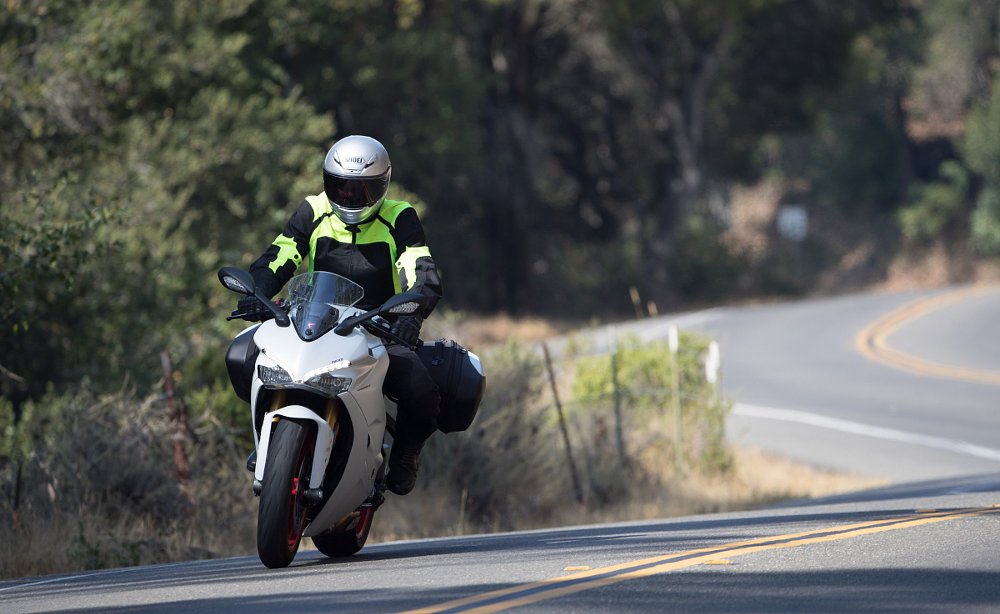
Why Ducati needed a SuperSport (and why you might, too)
Manufacturers have improved their race replica sport bikes so much that they're practically extinct. The Panigales, Gixxer thous and other bikes with Rs in their names have undeniably gotten more powerful, sharper handling and faster around a race track (at least in the hands of an expert rider). It's what manufacturers had to do to make their bikes competitive both on the track, in production-based series such as World Superbike, and on the spec sheets. But all that "improvement" also made them more expensive (both to buy and insure) and more complex, as greater and greater electronic sophistication had to be brought to bear to keep nearly 200 horsepower under control. Twenty years ago, a Honda CBR600F4i was both a Supersport race class contender and a good street bike, but today's race replicas just don't work that well on the street.
Sport bike sales have dropped as sales of mid-range naked bikes have risen. That's a problem for a company like Ducati, and while its Scrambler line has been hugely successful in expanding its customer base, what about those of us who like the looks of the Panigales and such but want something well suited for weekend sport rides and daily commuting? You know, the 362 days of the year we're not at a track day.
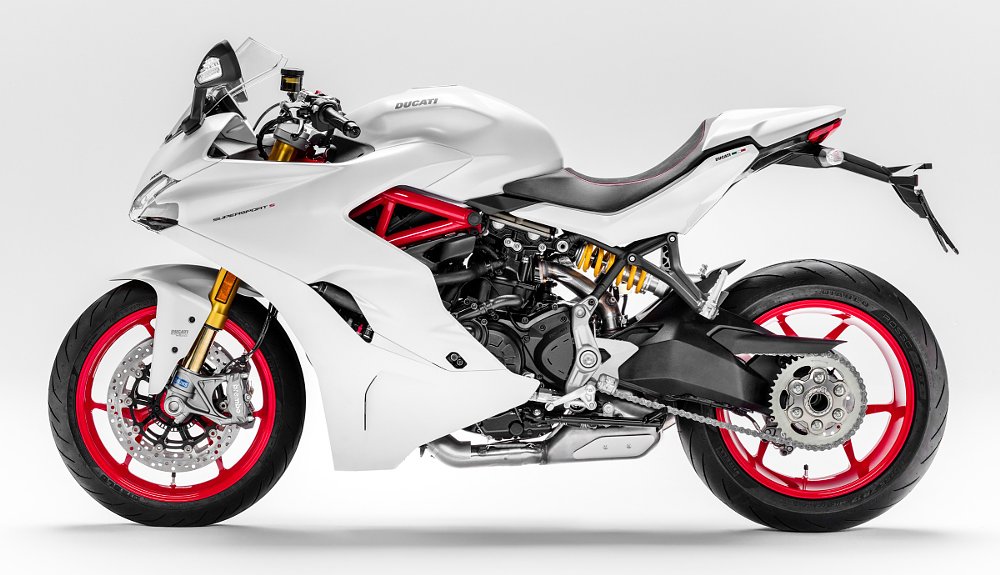
2018 Ducati SuperSport S
The SuperSport is built around the 937 cc 90-degree twin found in other Ducatis but redesigned and retuned for use in this new model. Ducati claims 113 horsepower at 9,000 rpm and 71.3 foot-pounds of torque at 6,500, so the power is more accessible at street speeds than track-focused bikes that want to be revved to five-digit engine speeds.
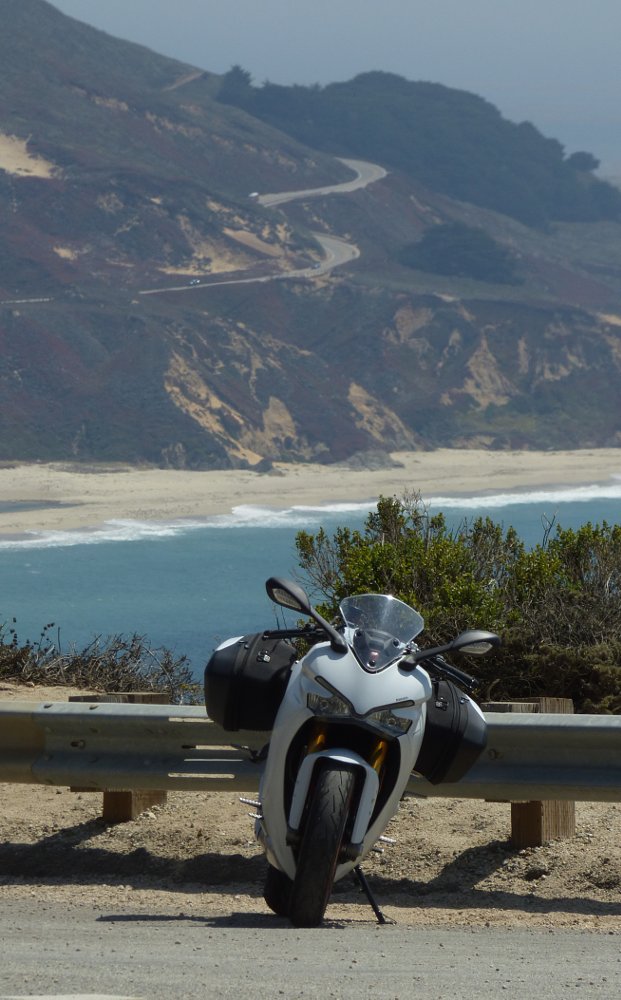
Ducati gave the SuperSport a very flexible electronic aids package. While some models give you some preset rider modes and one that you can customize to your own specifications, the SuperSport has three modes and you can fine-tune the settings on all three. Basically, you can have three custom maps.
The three modes preset from the factory are Sport, Touring and Urban. Within each, there are four parameters you can control: DTC, Ducati traction control, which has eight levels; ABS, which has three levels plus off; engine power, which can be set to high, medium or low; and DQS, which can be turned off or set to work with upshifts only or both up- and downshifts. This approach gives you a lot of flexibility. For example, while I only rode the bike on the street, the previous riders had taken it to the track and had a pro-level rider test it. He had customized the Sport setting for track use by lowering the DTC to the lowest level of intervention and turning off ABS. An owner could, for example, customize the Sport setting for track days, Touring for daily street riding and Urban for rainy days and perhaps never have to touch the adjustments.
If you do want to make fine-tuning changes, it's not unduly complicated. A button and a toggle on the left hand grip are used to scroll through displays on the dash and make changes to settings. A few minutes with the owner's manual had me clicking through the menu and making changes without too much difficulty.
As a not insignificant aside, it's no coincidence that the SuperSport's 18,000-mile valve adjustment interval is prominently noted on Ducati's web site and in the specifications table. Ducati is trying to counter the impression that their motorcycles require a lot of expensive maintenance.
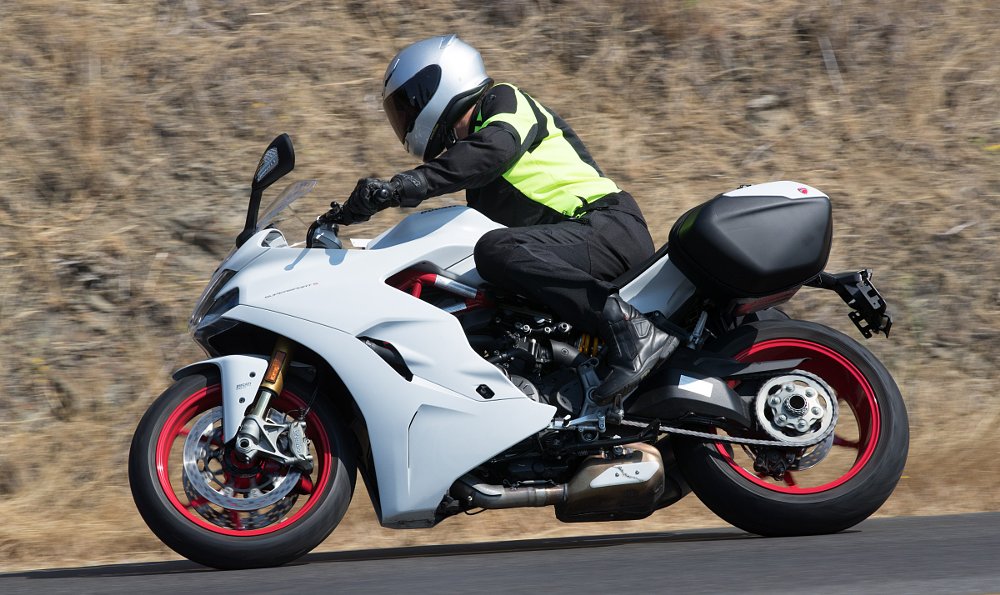
Riding the Ducati SuperSport S
I didn't put huge miles on the SuperSport S, but I did ride it in just about every situation an owner would typically encounter, except I did not ride it on the track. I picked up the white S at Ducati HQ in Mountain View, California, and headed north through Silicon Valley, surrounded on the road by an inordinate number of other Ducatis and the highest concentration of Teslas I've seen anywhere. I squeezed through San Francisco right at afternoon rush hour and worked my way north to spend the weekend covering the MotoAmerica round at Sonoma Raceway, where I dealt with another level of traffic congestion that took me by surprise. Photographer Brian J. Nelson consulted his magic atlas and we went to some curvy, less crowded roads to shoot some photos. Then I burned down the super-wide freeways east of the Bay and met my wife, who flew out for a couple of days so we could do a leisurely day ride down the Pacific Coast Highway to Big Sur. In short: urban streets, urban and suburban freeways, curvy two-lanes and an afternoon of riding two-up.
The ergonomics are right where you'd expect for a sport bike for the street. If you're coming from a race replica, the SuperSport will feel comfortable. If you're coming from anything else, it will feel sporty. The handgrips are above the top triple tree clamp and the foot pegs are a bit lower, but it's still a slightly more sporty position than a Kawasaki Ninja 1000 or a Honda VFR800 Interceptor, to cite two examples of traditional sport-touring machines on the sportier end of the spectrum. That was one of the first things that started swaying me to think of the SuperSport as a rational sport bike, not a sporty sport-touring bike.
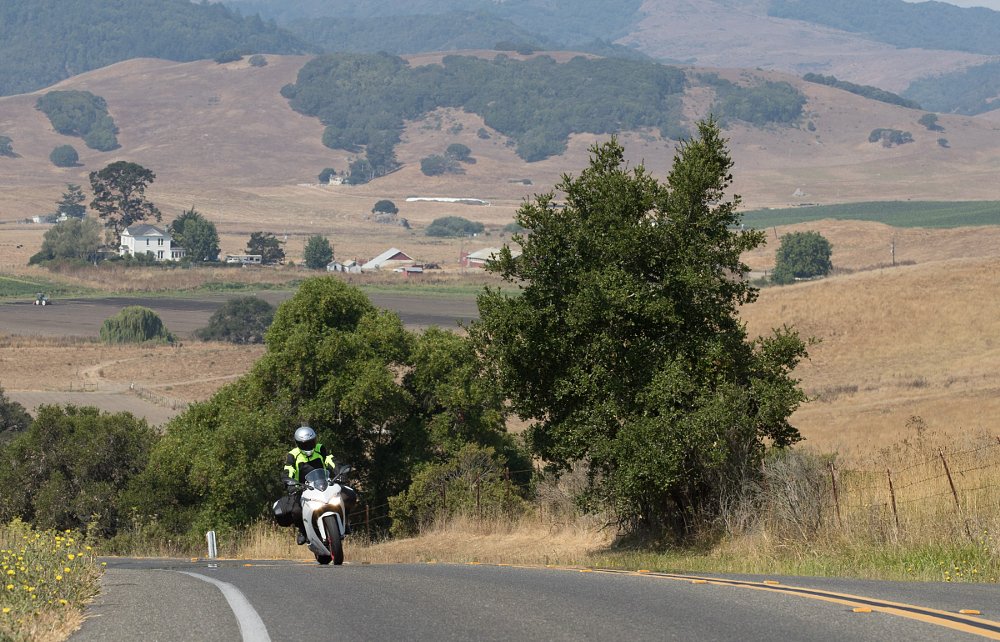
Bring the L-twin to life and the rumbly note will never let you forget it's a twin, not a multi-cylinder engine. I don't know how the two-into-one-into-two exhaust sneaked past the EPA decibel meter to obtain legal status.
The SuperSport has a cable-operated slipper clutch, but pull is not what I'd call light and it can be grabby (more on that later). Underway, the torquey twin makes easy work of traffic. While it pulls just fine from 3,500 rpm, I found the sweet spot was keeping the engine in the 5,000 to 7,000 rpm range for brisk riding, just surfing that torque peak. Revving up around the 9,000 rpm horsepower peak added to the forward momentum but it also added even more to the vibration level. I was relieved that throttle response was still well behaved after I switched into Sport mode. On some competitors, the sporty settings make the throttle so twitchy the motorcycle is not fun to ride. All three settings work well on the SuperSport.
In the city, even the 69-degree city of San Francisco, I felt quite a bit of heat coming off the rear cylinder while sitting at stop lights. By the time I'd crossed the Golden Gate Bridge heading north, I was already convinced the SuperSport was a rational sport bike, not a sport-tourer, encouraged by my toasty thighs, slightly tired clutch hand and the dawning realization that while this isn't my Triumph Daytona 675 (ergonomic torture in stop-and-go traffic), it does have a fairly committed riding position.
Once out of the city, I could give my clutch hand a rest and try the DQS. I'll admit it took this old dog a while to learn the new trick of using DQS, after decades of blipping the throttle for shifts. The DQS worked perfectly for upshifts, once I convinced myself just to hold the throttle steady and let the motorcycle sort it out. I never did get as good at the clutchless downshifts. There's been a lot of discussion among SuperSport owners on internet forums about DQS, and I suspect a lot of the issues some riders have are simply the result of getting used to it. Keep the revs above 3,500 and let the DQS work as it is designed to work and I think you'll find it's just fine.
Is it worth it? My personal take is that DQS is probably not something I'd pay extra for. I know some riders really love it, however, so it's a personal choice. I'd be tempted to save the $2,000 and go with the base model.
But... that also means giving up the Öhlins suspension. And while I've read good things about the suspension on the base SuperSport, the Öhlins pieces are sublime. Whether pounding over freeway expansion joints or wandering down a bumpy not-quite-two-lanes side road (where did I make a wrong turn?) to, most importantly, whooshing along the curvy roads near the coast, the suspension just capably soaked up everything. It never felt harsh on the freeway and it never felt wallowy when I was trying to lean just a little further in the hills. And that's despite the fact that I never even touched the settings. Good stuff.
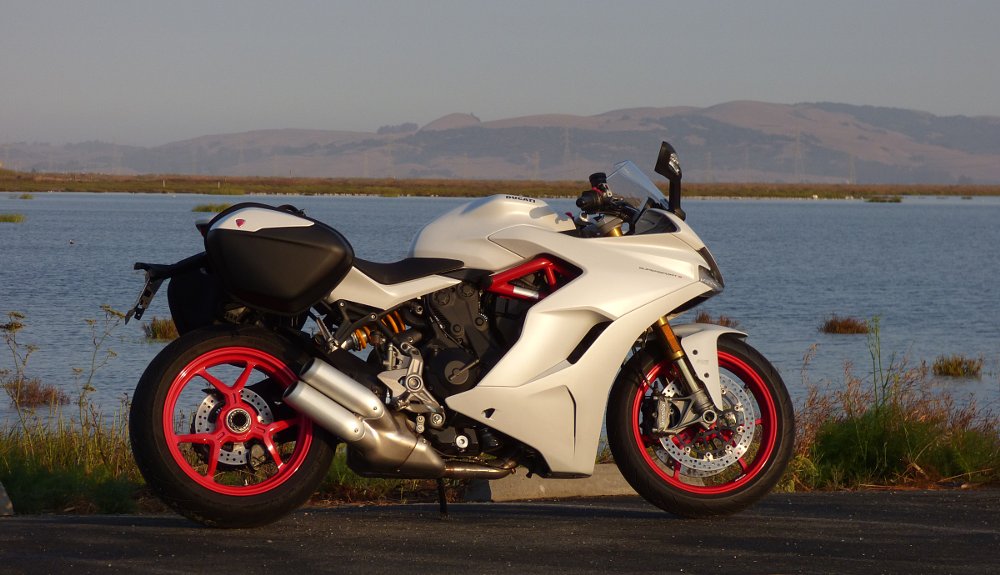
It doesn't surprise me that the two aspects SuperSport owners seem most pleased with are the looks and the handling. The sweet handling is aided and abetted by the Pirelli Diablo Rosso III tires that come stock on the SuperSport. I also like that they're standard sizes of 120/70ZR17 front and 180/55ZR17 rear, which means when they wear out you have a huge choice of replacements, from dedicated track-day tires to long-wearing sport-touring tires, so you can buy whatever suits your riding profile.
Both models of SuperSports use radial-mount Brembo Monobloc M4-32 calipers and 320 mm discs in front. That's not quite the top-spec Brembos you'll find on the racier Ducatis, but for this hundredish-horsepower bike, they work great and provide good feedback. This rider totally approves.
The windscreen is adjustable to two positions. It's spring-loaded, so it can be switched to high or low in a second with no tools. I didn't feel a huge difference and neither position created any bothersome buffeting for me, so I mostly left it in the low position.
The summary of my riding impression is that the SuperSport S is a sweet-handling sport bike with power you can access in the kind of riding we do on the streets and highways of the real world — and it will still make a very capable track-day mount, if you want to do that, too. When I hear riders say they "need" 160 horsepower, I tend to think what they really need is to learn how to keep a motorcycle in its powerband and ride it properly. The SuperSport will get you well into triple-digit speeds in second gear, so why again does it need 50 more horsepower?
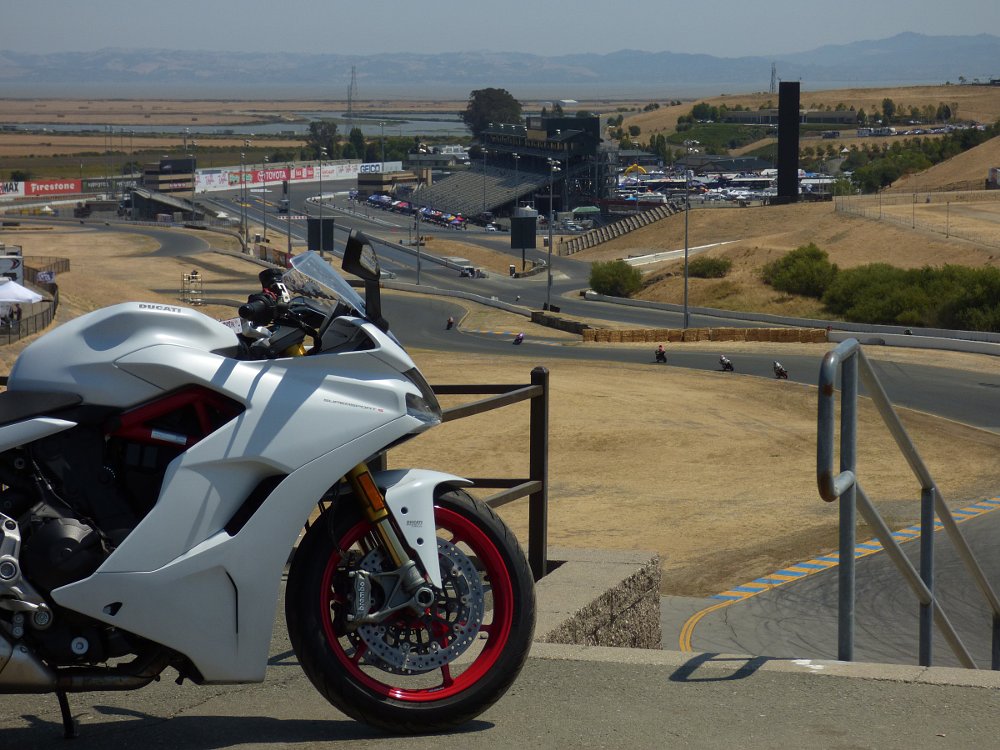
Quibbles with the Ducati SuperSport S
The list of things I don't like is short. The list of things I'll mention just because some other riders might not like them is still short, but a few items longer.
The biggest annoyance for me was a very grabby clutch when cold. I stalled the bike four or five times when trying to set out for the first ride of the morning, even after I learned it needed to be feathered very, very carefully until the oil was warm. It's a combination of a tall first gear and a narrow engagement point on the clutch when cold, like a light switch. It's an annoyance, not a fatal flaw, because it works perfectly once warmed up. But it was bad enough that the one day I took my wife for a two-up ride, I went out and rode around for a couple of miles to get the engine warm, because I did not want to try to take off on a cold bike with her on the back. The most careful feathering of the clutch I could muster couldn't completely avoid an awkward lurch if the engine was cold.
Perusing the Ducati forums, it seems some SuperSport owners have this complaint, to varying degrees, and others don't. The Ducati rep said it was something that would probably improve with break-in, but the bike I rode had more than 3,000 miles on it when I turned it in, so it wasn't straight out of the crate.
I know from our comments section that some people care about engine heat, which is why I mentioned it earlier. Also, I suspect some people will be disappointed the SuperSport S doesn't have a full-color TFT display like some of its competitors. Personally, I'm happy with the single-color display, which crams a lot of information into the dash but is still legible. The bar tachometer across the top is probably one of the easiest to read of its kind, helped by the fact that a little "4" pops up as you cross 4,000 rpm, and then a "5" when you hit 5,000, etc.
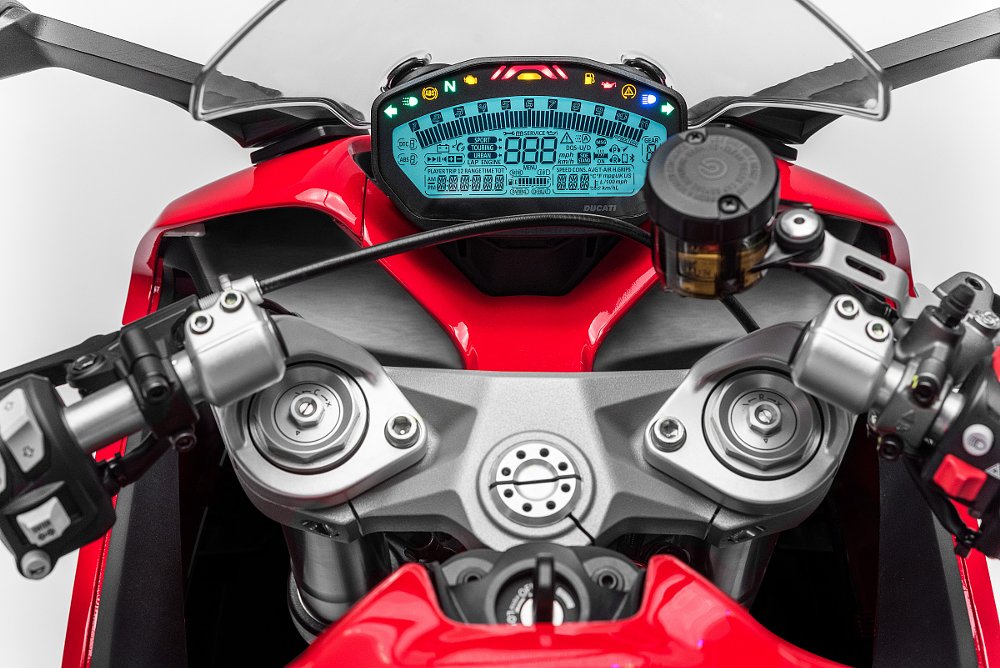
Really, that's it for complaints. Unless you make the mistake I did and think the SuperSport is a sport-tourer. Then there are some details you may find coming up short of what you need.
Why I no longer think of the SuperSport as a sport-tourer
Sport-touring used to be a spectrum covering riders ranging from those who feel shaft drive and electrically adjustable windscreens are a must and who ride bikes like the Yamaha FJR1300 to riders on something sportier, like a Honda Interceptor. Then the spectrum grew an appendage as people began buying upright, ADV-styled bikes with thoroughly street-going bits like 17-inch wheels with sporty rubber, like Ducati's own Multistrada.
The SuperSport fits in at the very sporty end of the traditional sport-touring spectrum. It would certainly be fun for a long weekend of backroads riding, but there are a few areas where travelers going longer distances might find compromises that wouldn't be noticed by the rider using the SuperSport for sport use. One is range. The 4.2-gallon tank isn't going to provide the 200-mile range some consider appropriate for sport-touring duty. The dash has a range countdown that I suspect was very conservative because it never took as much gas to fill the tank as I expected, based on the display, but I didn't want to test my theory and end up pushing. As a result, I never went more than 150 miles between gas stops.
The other issue is luggage. The color-matched panniers look nice, but they do not provide the weatherproofness or security most people are looking for on multi-day rides. They are a mix of heavy fabric and hard panels and close with a zipper, so there's no real way to make them tamper proof when you're away from the parked bike. The bags can be removed with a key, but not the ignition key. And when you do remove the bags, the black brackets remain behind (quite noticeable on a white bike).
Those limitations would be easier to accept if the panniers didn't cost $1,499. It's not surprising a lot of SuperSport owners opt for aftermarket luggage solutions.
One thing that is neat about the factory panniers is that a second zipper allows for an expansion panel to open, making it possible to fit a helmet inside. Lane-splitters note, however, that in either configuration, the panniers extend wider than the narrower handgrips.
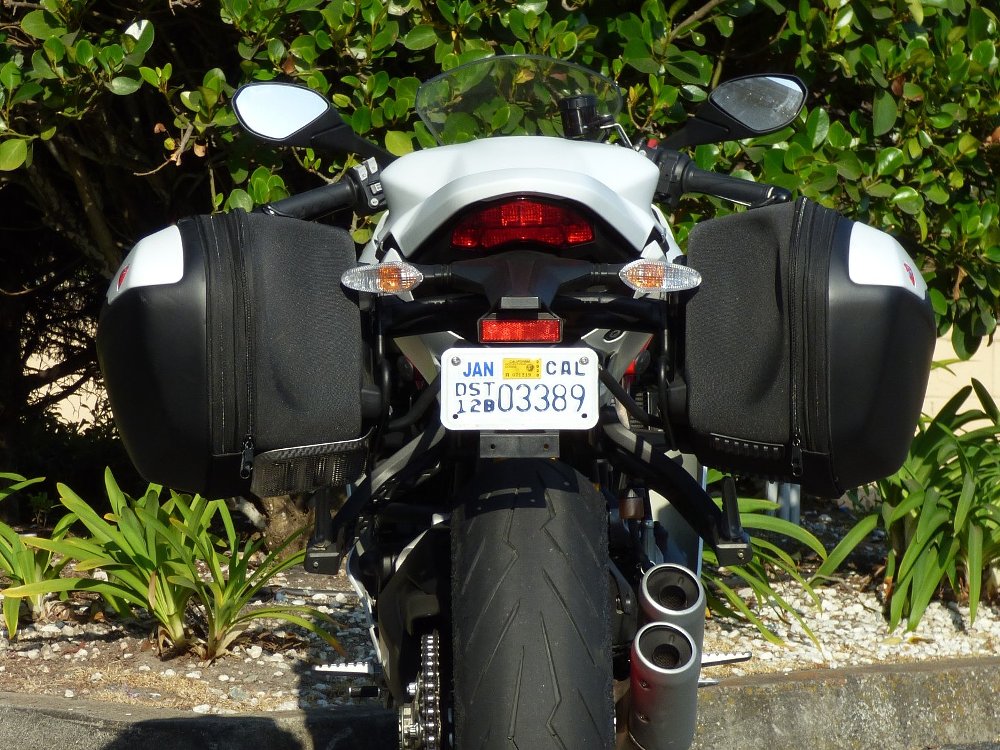
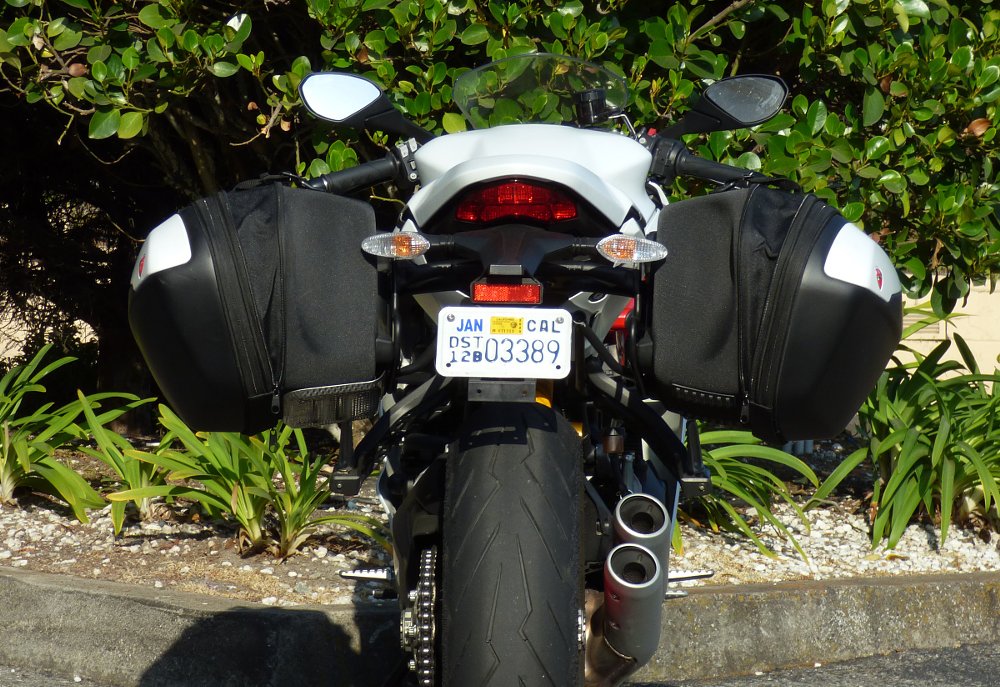
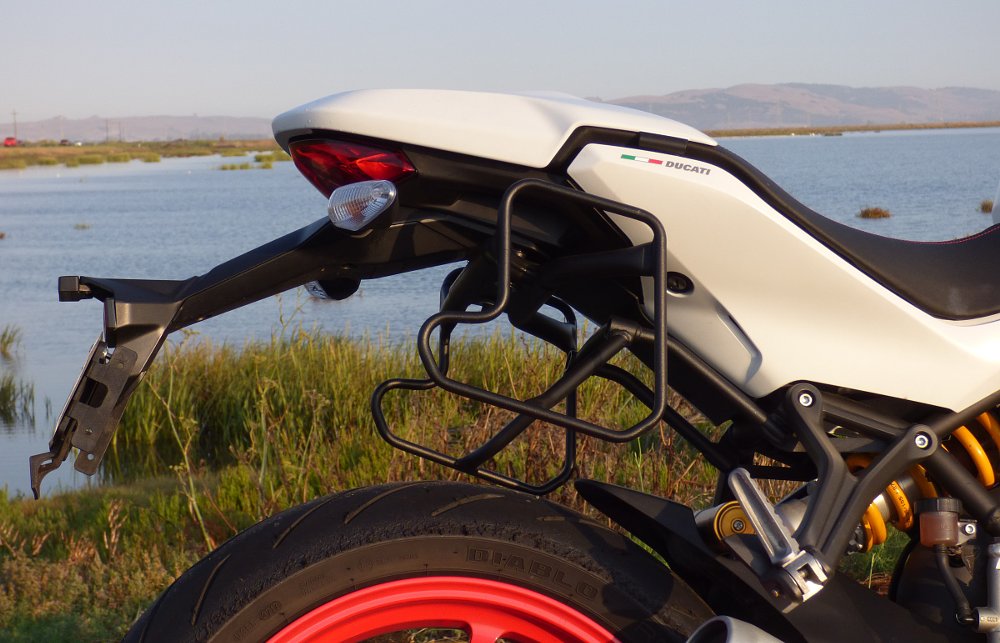
Two-up on the SuperSport S
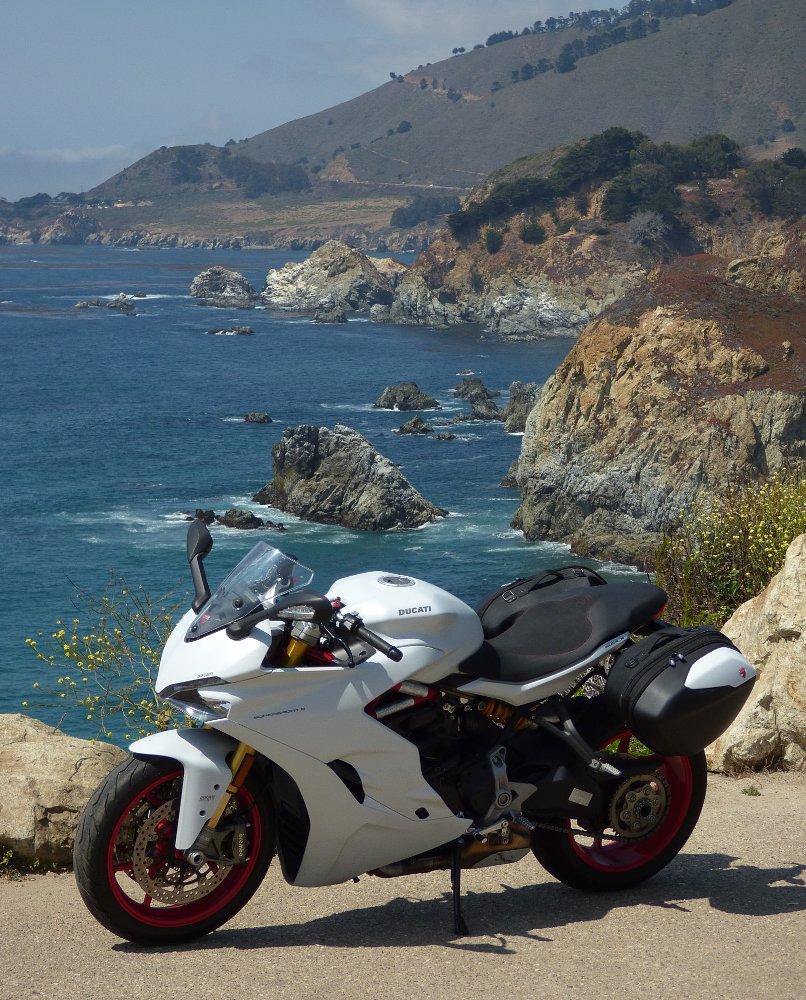
Well, except for the suspension. The Öhlins shock continued to work well, but I could have used more preload. Unlike a true sport-touring bike like a Ninja 1000, the SuperSport has no remote preload adjuster and I was not going to be able to move the collar on the shock with the reversible screwdriver I found under the seat, so we made do.
Ivonne's only complaint was the lack of a handhold. She found the seat to be comfortable for the amount of time we were on the bike. She noted the footpegs were high, but they didn't bother her. She is five feet tall, however, and we both suspected a passenger with longer legs would have issues. Again, perspective matters. A passenger coming from a race replica will find the SuperSport comfortable. A passenger used to anything else will consider the accommodations less friendly.
Bottom-line verdict from the pillion: Sure, Ducati made some compromises in the name of making a beautiful, sporty bike, but it's worth it because the SuperSport is a fine-looking machine. Ivonne's a sucker for flashy Italian shoes, so maybe she was just smitten from the moment she saw the red wheels.
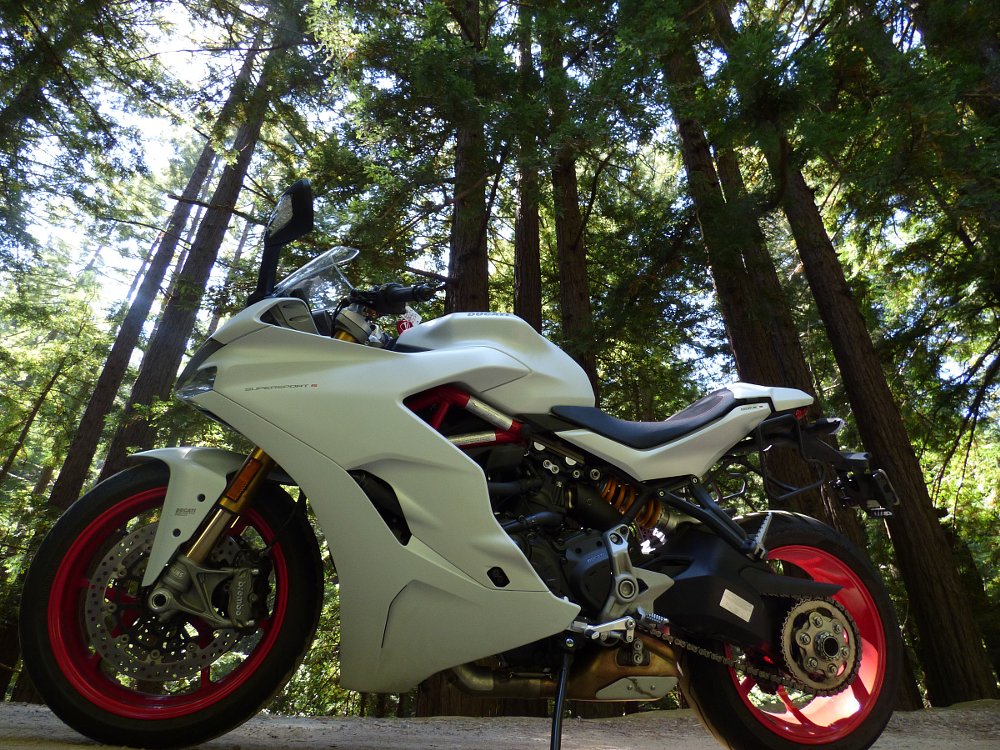
How the SuperSport S stacks up
As a sporty sport-tourer, which is how I originally perceived the SuperSport S, it has a few shortcomings. But judged for what Ducati said it was all along — a sport bike that makes sense where most of us actually ride sport bikes — it's hard to find much wrong with the SuperSport S. It's also hard to find many direct competitors.
The race replicas have peaky powerbands and punishing ergonomics. Even the sportiest sport-tourers, like the Ninja 1000, feel less agile. Soft-edged sport bikes like the Ninja 650 are less sophisticated and less powerful. Naked bikes offer a totally different look and riding position.
From its eyebrow daytime running lights, through its curvaceous fairing and on to the signature single-sided swingarm, the SuperSport strikes me as a beautiful bike. It's clear a lot of owners were won over by those looks, too. Fortunately, if you're looking for a sporty twin and you're mature enough to buy based on real-world ability rather than a track-oriented spec sheet, there's no reason not to let yourself be won over by a pretty face. The SuperSport S works as good as it looks.
| 2018 Ducati SuperSport S | |
|---|---|
| Price (MSRP) |
Red: $14,995 White: $15,395 |
| Engine Type | Liquid-cooled, 90-degree twin, four valves per cylinder |
| Displacement | 937 cc |
| Bore x stroke | 94 mm x 67.5 mm |
| Power | 113 horsepower @ 9,000 rpm |
| Torque | 71.3 foot-pounds @ 6,500 rpm |
| Transmission | six gears |
| Front Suspension | Öhlins 48 mm fork, adjustable preload, rebound and compression damping |
| Rear Suspension | Öhlins monoshock, adjustable preload, rebound and compression damping |
| Front Brake | Twin 320 mm discs, Brembo M4-32 four-piston radially mounted calipers; ABS standard |
| Rear Brake | Single 245 mm disc, two-piston caliper; ABS standard |
| Tires front/rear | 120/70ZR17; 180/55ZR17 |
| Steering head angle | 24 degrees |
| Wheelbase | 58.2 inches |
| Seat height | 31.9 inches |
| Tank capacity | 4.2 gallons |
| Wet weight | 463 pounds |

















